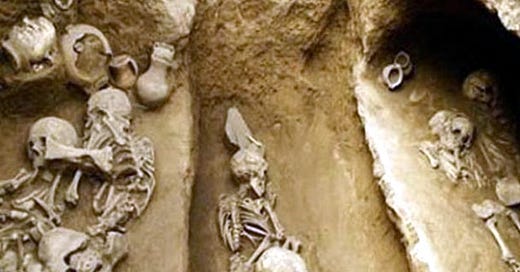ANCIENT CHINESE CEMETERY CONTAINS REMAINS OF HUMAN SACRIFICIAL VICTIMS
In northwest China in tombs near Mogou village, archaeologists have found hundreds of graves that contain the remains of victims of human sacrifice. This cemetery dates back more than 4,000 years.

The excavation of 300 tombs took place between 2009 to 2011. The majority of them are believed to belong to the Neolithic Qijia culture (2200BC-1600BC). Evidence of the Qijia culture was first discovered in the 1920s by Swedish geologist Johann Gunnar Anderson in the village of Qijiaping. Not only were there individual burials in the Mogou Cemetery, but in some cases entire families were interred with their heads facing northwest.
Adjacent to the remains were small rooms containing pottery, as well as necklaces, bronze sabers, maces, axes daggers and knives.
There were other discoveries which indicated that human sacrifice had been performed. The victim was placed on its side with bent limbs and facing the entrance to the tomb. The bones were well-preserved, and belonged to a 13-year old.
The researchers are not sure why the Qijia sacrificed humans, but there were more female victims than male. There were also the bones of pigs in the tomb.
It is believed humans sacrificed in the tombs served as a “culturally sanctioned mechanism” to reinforce social hierarchies, and demonstrate the powers of the ruling elite, as well as to continue their family line.
One theory is they might be conquered people, who they used as slaves and sacrifice victims. The sacrifice may have been performed to honor the dead who were about to be buried, since they were of a higher social value than the victim.
The victims’ bodies were treated poorly. The limbs were purposely separated, and did not have any goods to be used in the afterlife.
One man was executed by being stabbed twice in the back, below the shoulder blades and at the base of the neck. This was done while he was kneeling or lying down.
Human sacrifice peaked in China during the Shang dynasty (1600-1046BC) due to the creation of a slave society, which brutally sacrificed at least 14, 197 people. Some of the slaves could have also been prisoners of war, which were considered the same as livestock. This is why slaves were left next to animals inside the tomb.
The sacrifice and burial differed from other examples from China, where societies placed skulls in the foundation of temples or important buildings as a blessing to the new construction. Instead, the intimate nature of the Mogou killing pushed the team towards the idea that the execution was meant to subordinate the victim to the other people inside the tomb.
Qijia culture sites are found along the upper Yellow River and its tributaries. One of their communities was struck down by an unknown prehistoric disaster in which those strong enough to flee quickly escaped leaving their children and the elderly behind.

Archaeologists also found evidence of rituals where human bones were used for divination, which was widely practiced throughout China.
According to Herbert Plutschow from the University of California, oracle bones from animals and human sacrifices were used in China to "purify" a royal ancestor.
The deceased ancestor would have a choice of either an animal or human sacrifice, with men from the Ch'iang tribe, who raised sheep as the preferred victim.
The question asked was: Should the purification before Tsu-ting be done with the sacrifice of three oxen pairs and ten men of Ch'iang?"




